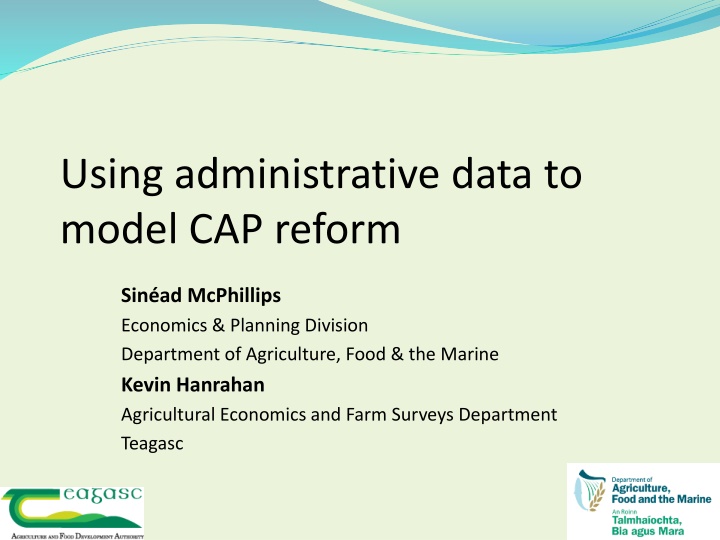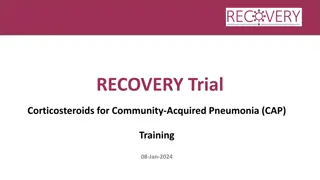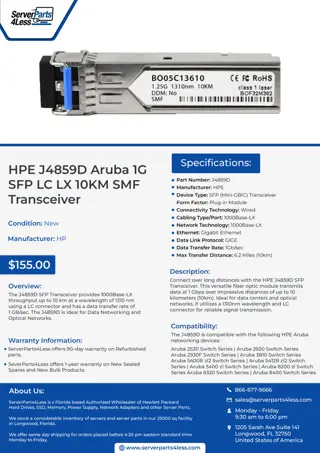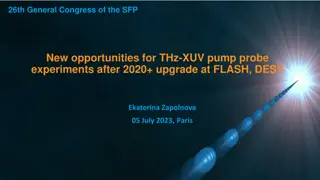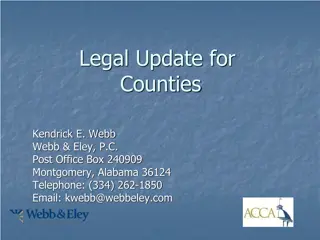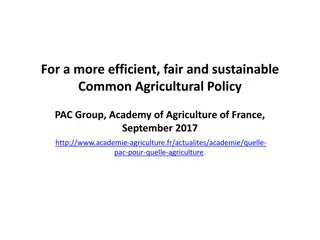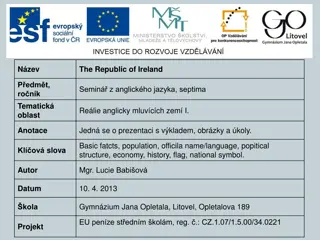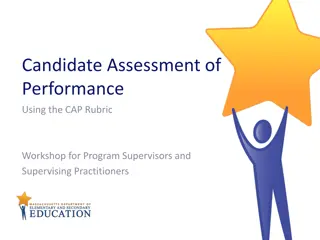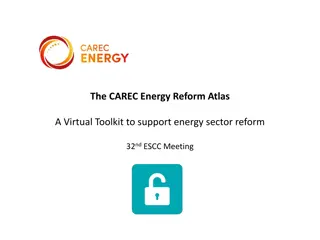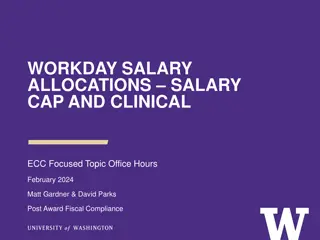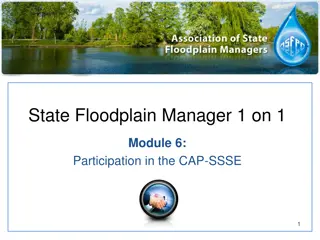Analysis of CAP Reform Proposals and SFP Distribution in Ireland
This content discusses the use of administrative data to model Common Agricultural Policy (CAP) reform in Ireland, focusing on Commission proposals, internal convergence, and the distribution of Single Farm Payments (SFP). It covers analyses by the Department of Agriculture, Food and the Marine, as well as insights from Teagasc on farm types and payment distribution. The data reveals the average payments per hectare and sheds light on the 2010 SPS database and payment distribution among farmers.
Download Presentation

Please find below an Image/Link to download the presentation.
The content on the website is provided AS IS for your information and personal use only. It may not be sold, licensed, or shared on other websites without obtaining consent from the author.If you encounter any issues during the download, it is possible that the publisher has removed the file from their server.
You are allowed to download the files provided on this website for personal or commercial use, subject to the condition that they are used lawfully. All files are the property of their respective owners.
The content on the website is provided AS IS for your information and personal use only. It may not be sold, licensed, or shared on other websites without obtaining consent from the author.
E N D
Presentation Transcript
Using administrative data to model CAP reform Sin ad McPhillips Economics & Planning Division Department of Agriculture, Food & the Marine Kevin Hanrahan Agricultural Economics and Farm Surveys Department Teagasc The logo of the Department of Agriculture, Fisheries and Food Teagasc - The Irish Agriculture and Food Development Authority
Overview Commission proposals on SFP DAFM analysis Irish internal convergence proposal Comparisons with other proposals Modelling by Teagasc on farm types Conclusions
COMMISSION PROPOSALS ON SFP Distribution of Direct Payments within Member States ( internal convergence ): Progressive movement to uniform national or regional payment rates per hectare by 2019 Entitlements based on eligible hectares declared in 2014 by active farmers with at least one entitlement in 2011
DAFM analysis Modelling based on DAFM administrative data Objective: To quantify effects of Commission proposals, & to develop and propose alternatives Administrative data collected by DAFM (such as contained in the SPS application form) provides a wealth of useful data eligible area payment amount stocking density
2010 SPS database Average payment per hectare category, 2010 Average Area (ha) Average payment per ha (2010) No of farmers Total Area 2010 SPS Payment 0 payment, some area 7,955 144,159 0 18.1 0.00 0 to 20 1,963 67,579 771,200 34.4 11.41 20 to 50 4,176 179,217 6,512,194 42.9 36.34 50 to 100 10,482 397,131 29,951,263 37.9 75.42 100 to 150 13,135 423,446 53,110,201 32.2 125.42 150 to 200 15,462 493,919 86,753,342 31.9 175.64 200 to 250 16,953 571,978 128,911,363 33.7 225.38 250 to 300 16,709 603,410 165,984,643 36.1 275.08 300 to 400 25,936 1,025,283 354,750,285 39.5 346.00 400 to 500 11,084 473,984 209,656,007 42.8 442.33 500 to 600 4,446 197,559 107,207,633 44.4 542.66 600 to 700 1,815 80,239 51,594,069 44.2 643.01 700 to 800 803 33,006 24,678,914 41.1 747.71 800 to 900 378 16,388 13,801,287 43.4 842.13 900 to 1,000 167 5,947 5,648,677 35.6 949.88 1,000+ 338 7,726 9,182,251 22.9 1,188.44 All 131,802 4,720,971 1,248,513,329 35.8 264.46
2010 SPS payment distribution 2010 SPS Payment No of farmers 1,000+ 900 to 1,000 800 to 900 700 to 800 1% 600 to 700 1% 500 to 600 3% 400 to 500 8% 300 to 400 20% 250 to 300 13% 200 to 250 13% 150 to 200 12% 100 to 150 10% 50 to 100 8% 20 to 50 3% 0 to 20 1% 0 payment, some 6% 0% 5% 10% 15% 20% 25% 30%
Models analysed Flat rate national Flat rate at NUTS 2 & NUTS 3 level Regions based on stocking density All resulted in large transfers within regions/local area as well as between regions
Example: Average payment per ha by NUTS III region, 2010 350 337 310 300 300 283 264 258 250 216 207 200 150 100 50 0 Border Midlands West Dublin Mid East Mid West South East South West
IRISH PROPOSAL ON INTERNAL CONVERGENCE Approximation - move towards the average Applies to the whole payment (green and basic) Based on commission s proposals for external convergence Results; average gains of 29% for 65,000 farmers, average losses of 9% for 56,000. Those with highest payments lose most. 5 Member States supportive (Spain, Portugal, Italy, Denmark and Luxembourg)
Irish Proposal Internal Convergence Breakdown Payment category (SPS euro per ha 2010) No of farmers % change compared to 2010 0 to 20 20 to 50 50 to 100 100 to 150 150 to 200* 200 to 238.01 GAIN 1,939 4,129 10,350 12,998 15,300 12,712 65,052 +662% +185% +72% +30% +12% +3% +29% NO CHANGE: 238.02 TO 264.46 (90% to 100%) 264.47 to 300 300 to 400 400 to 500 500 to 600 600 to 700 700 to 800 800 to 900 900 to 1,000 1,000+ LOSS TOTAL 8,943 11,717 25,658 10,919 4,368 1,763 769 348 153 221 55,916 129,911 - -2% -6% -11% -14% -16% -17% -18% -19% -21% -9% +0% Note: All figures are estimates only, based on modelling exercises carried out by DAFM, using eligible area and actual payments to farmers in 2010, in order to analyse the overall impact of alternative proposals on Irish farmers.
OTHER PROPOSALS EMERGING However, other Member States have other ideas In addition, other proposals are coming from the European Parliament all the time this is a moveable feast CAP reform now s.t. ordinary legislative procedure , i.e. co-decision of Council and Parliament
Comparative Analysis: Commission, Capoulas Santos (EP) and Irish Minister s Proposals Commission proposals - national flat rate Capoulas Santos proposals on internal convergence Ireland's proposal - External convergence approach 73,995 73,995 65,052 No. of farmers gaining +85% +56% +29% Average % loss - - 8,943 55,916 55,916 55,916 No. of farmers losing -33% -23% -9% Average % loss 297m 197m 79m Total transfers m Note: All figures are estimates only, based on modelling exercises carried out by DAFM, using eligible area and actual payments to farmers in 2010, in order to analyse the overall impact of alternative proposals on Irish farmers.
MODELLING BY TEAGASC Adding data from the AIM and other DAFM databases (animal numbers and type) So as to allow farms to be categorised according to the FADN farm typology Similar approach to that used in Census of Agriculture typing of farms Useful for CAP negotiations Database could be adapted for a variety of analytical purposes
SPS Payment Share of FFI by Farm System (NFS 2010) impact on income of a euro change in subsidy depends on the farming system s subsidy dependence 120% 100% 80% 60% 40% 20% 0% Dairying Cattle Rearing Cattle Other Sheep Tillage Mixed Livestock All Farms Teagasc 2010 NFS (Hennessy et al. 2011)
Farms by Farm System and Economic Size 40,000 35,000 30,000 number of farms 25,000 20,000 15,000 10,000 5,000 0 DY ML CR CO SH P151 NP151 S M L 1 ESU = 1,200 SO S 8 ESU; 8<M 40 ESU; L>40 ESU
Flat Rate Payment Model (EC proposal) Winners and Losers by system W= 75,011 & L = 56,764 25,000 20,000 Numbers of farms 15,000 10,000 5,000 0 Dairying Mixed Livestock Cattle Rearing Cattle Other Sheep P151 NP151
Results from Teagasc analysis Reform is a zero-sum game If there are losers there are winners/If there are winners there are losers Specialist dairying and tillage, which are more intensive systems, have more losers than winners, but still a substantial number of winners. Drystock farms, by contrast, have more winners than losers, but still have a surprising number of losers. Largest absolute gains/losses on those farms that are larger recipients of DP Larger relative gains on farms with smaller DP receipts Doesn t make sense to talk about cattle men winning and dairy men losing there are winners and losers in all farm types
Cattle Rearing: SPS subsidy/ha EC proposals 800 14000 700 12000 600 10000 500 SPS euro/ha 8000 farms 400 6000 300 4000 200 2000 100 0 0 0-1000 1000- 2000- 5000 5000- 10000 10000- 15000 15000- 20000 20000- 25000 25000- 30000 30000- 40000 40000- 50000 >50000 2000 Winners Losers n
Cattle Rearing Farm System: SO/ha EC proposals 900 14000 800 12000 700 10000 600 euro SO/ha 8000 500 farms 400 6000 300 4000 200 2000 100 0 0 0-1000 1000- 2000- 5000 5000- 10000 10000- 15000 15000- 20000 20000- 25000 25000- 30000 30000- 40000 40000- 50000 >50000 2000 Winners Losers n
Dairy: SPS subsidy/ha EC proposals 700 6000 600 5000 500 4000 SPS euro/ha 400 farms 3000 300 2000 200 1000 100 0 0 0-1000 1000- 2000- 5000 5000- 10000 10000- 15000 15000- 20000 20000- 25000 25000- 30000 30000- 40000 40000- 50000 >50000 2000 Winners Losers n
Dairy Farm System: SO/ha EC proposals 3,000 6000 2,500 5000 2,000 4000 euro SO/ha farms 1,500 3000 1,000 2000 500 1000 0 0 0-1000 1000- 2000- 5000 5000- 10000 10000- 15000 15000- 20000 20000- 25000 25000- 30000 30000- 40000 40000- 50000 >50000 2000 Winners Losers n
CONCLUSIONS Detailed administrative data allows more precise modelling of the effects of policy change Can provide insights not provided by other data Particularly useful when comparing one proposal against another Still have to bear in mind that they are just models Not predictive of what will happen in the real world Cannot provide information on income or production effects
